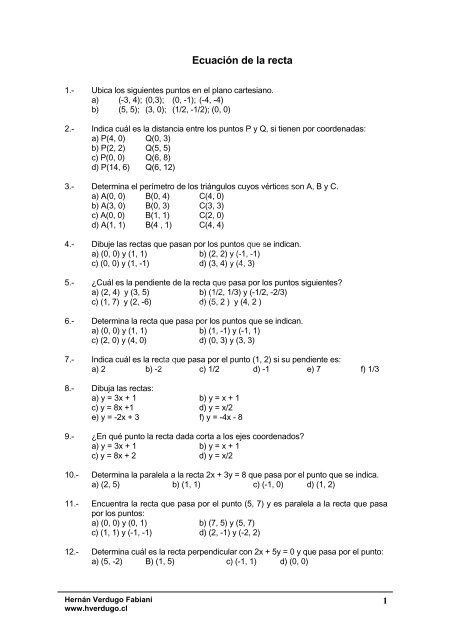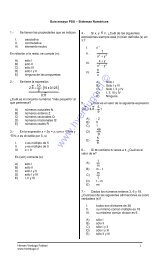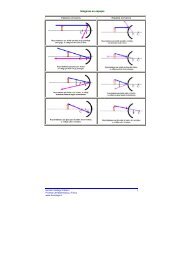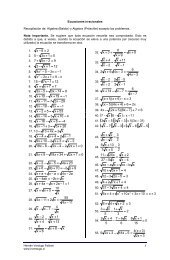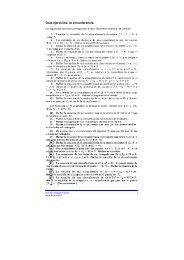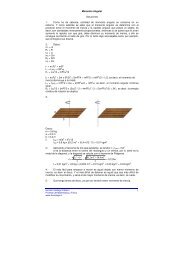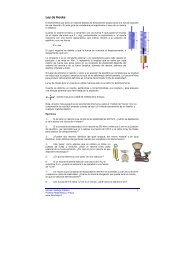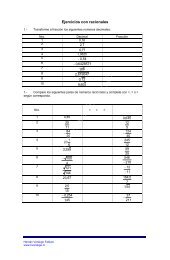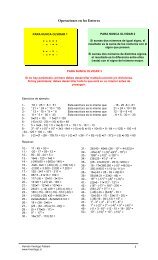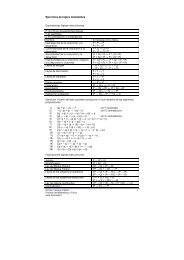Ecuación de la recta
Ecuación de la recta
Ecuación de la recta
Create successful ePaper yourself
Turn your PDF publications into a flip-book with our unique Google optimized e-Paper software.
Ecuación <strong>de</strong> <strong>la</strong> <strong>recta</strong><br />
1.- Ubica los siguientes puntos en el p<strong>la</strong>no cartesiano.<br />
a) (-3, 4); (0,3); (0, -1); (-4, -4)<br />
b) (5, 5); (3, 0); (1/2, -1/2); (0, 0)<br />
2.- Indica cuál es <strong>la</strong> distancia entre los puntos P y Q, si tienen por coor<strong>de</strong>nadas:<br />
a) P(4, 0) Q(0, 3)<br />
b) P(2, 2) Q(5, 5)<br />
c) P(0, 0) Q(6, 8)<br />
d) P(14, 6) Q(6, 12)<br />
3.- Determina el perímetro <strong>de</strong> los triángulos cuyos vértices son A, B y C.<br />
a) A(0, 0) B(0, 4) C(4, 0)<br />
b) A(3, 0) B(0, 3) C(3, 3)<br />
c) A(0, 0) B(1, 1) C(2, 0)<br />
d) A(1, 1) B(4 , 1) C(4, 4)<br />
4.- Dibuje <strong>la</strong>s <strong>recta</strong>s que pasan por los puntos que se indican.<br />
a) (0, 0) y (1, 1) b) (2, 2) y (-1, -1)<br />
c) (0, 0) y (1, -1) d) (3, 4) y (4, 3)<br />
5.- ¿Cuál es <strong>la</strong> pendiente <strong>de</strong> <strong>la</strong> <strong>recta</strong> que pasa por los puntos siguientes?<br />
a) (2, 4) y (3, 5) b) (1/2, 1/3) y (-1/2, -2/3)<br />
c) (1, 7) y (2, -6) d) (5, 2 ) y (4, 2 )<br />
6.- Determina <strong>la</strong> <strong>recta</strong> que pasa por los puntos que se indican.<br />
a) (0, 0) y (1, 1) b) (1, -1) y (-1, 1)<br />
c) (2, 0) y (4, 0) d) (0, 3) y (3, 3)<br />
7.- Indica cuál es <strong>la</strong> <strong>recta</strong> que pasa por el punto (1, 2) si su pendiente es:<br />
a) 2 b) -2 c) 1/2 d) -1 e) 7 f) 1/3<br />
<br />
8.- Dibuja <strong>la</strong>s <strong>recta</strong>s:<br />
a) y = 3x + 1 b) y = x + 1<br />
c) y = 8x +1 d) y = x/2<br />
e) y = -2x + 3 f) y = -4x - 8<br />
9.- ¿En qué punto <strong>la</strong> <strong>recta</strong> dada corta a los ejes coor<strong>de</strong>nados?<br />
a) y = 3x + 1 b) y = x + 1<br />
c) y = 8x + 2 d) y = x/2<br />
10.- Determina <strong>la</strong> parale<strong>la</strong> a <strong>la</strong> <strong>recta</strong> 2x + 3y = 8 que pasa por el punto que se indica.<br />
a) (2, 5) b) (1, 1) c) (-1, 0) d) (1, 2)<br />
11.- Encuentra <strong>la</strong> <strong>recta</strong> que pasa por el punto (5, 7) y es parale<strong>la</strong> a <strong>la</strong> <strong>recta</strong> que pasa<br />
por los puntos:<br />
a) (0, 0) y (0, 1) b) (7, 5) y (5, 7)<br />
c) (1, 1) y (-1, -1) d) (2, -1) y (-2, 2)<br />
12.- Determina cuál es <strong>la</strong> <strong>recta</strong> perpendicu<strong>la</strong>r con 2x + 5y = 0 y que pasa por el punto:<br />
a) (5, -2) B) (1, 5) c) (-1, 1) d) (0, 0)<br />
Hernán Verdugo Fabiani<br />
www.hverdugo.cl<br />
1
13.- ¿Qué posición tienen entre sí los siguientes pares <strong>de</strong> <strong>recta</strong>s? (parale<strong>la</strong>s,<br />
perpendicu<strong>la</strong>res, coinci<strong>de</strong>ntes, secantes)<br />
a) 2x + 3y = 0 y 3x - 2y = 0<br />
b) x = y y x = y + 8<br />
c) 4x + 2y + 1 = 0 y 8x + 4y + 2 = 0<br />
d) 7x + y = 0 y x + 3y = 2<br />
14.- Determine el valor <strong>de</strong> k tal que <strong>la</strong> <strong>recta</strong> 2x + 3ky + 10 = 0 pase por el punto (4, -2).<br />
15.- Determina si están alineados los siguientes puntos: A(0, 0); B(2, 1) y C((-3, -6)<br />
16.- Determine <strong>la</strong> ecuación <strong>de</strong> <strong>la</strong> <strong>recta</strong> que pasa por los puntos<br />
a) A(0, 0) y B(0, 4) b) A(7, 0) y B(0, -4)<br />
c) A(1, 3) y B(-1/3, 0) d) A(6/5, -3/2) y B(1,2; 0)<br />
17.- ¿Cuál es <strong>la</strong> <strong>recta</strong> que pasa por (-1, 0) y su pendiente es 0?<br />
18.- ¿Cuál es <strong>la</strong> pendiente <strong>de</strong> <strong>la</strong> <strong>recta</strong> que pasa por los puntos (1, 3) y (7, 1)?<br />
19.- Determina k <strong>de</strong> modo tal que <strong>la</strong> <strong>recta</strong> que pasa por (k, 3) y (-2, 1) sea<br />
perpendicu<strong>la</strong>r con <strong>la</strong> <strong>recta</strong> que pasa por (5, -2) y (13/2, 4)<br />
20.- Demuestre que al unir los puntos A = (3, -1), B = (8, 2), C = (2, 1) y D = (-3, 0) no<br />
se forma un paralelogramo.<br />
21.- Indica si el punto (1/2, 1) pertenece a <strong>la</strong> <strong>recta</strong> que pasa por los puntos: (-3, -5) y<br />
(4, 7)<br />
22.- Determina k para que <strong>la</strong> <strong>recta</strong> <strong>de</strong> ecuación 2x + 3ky -20 = 0 pase por el punto P =<br />
(-2, 4)<br />
23.- Encuentre <strong>la</strong> <strong>recta</strong> parale<strong>la</strong> a <strong>la</strong> <strong>de</strong> ecuación: x + y = 0, y que pasa por el punto P<br />
= (1, 2)<br />
<br />
24.- Tres vértices <strong>de</strong> un rectángulo son (2,-1), (7, -1) y (7, 3). Encuentre el otro vértice.<br />
25.- Encuentre el área <strong>de</strong>l triángulo cuyos vértices son (1, -2), (4, -2) y (4, 2).<br />
Hernán Verdugo Fabiani<br />
www.hverdugo.cl<br />
2


